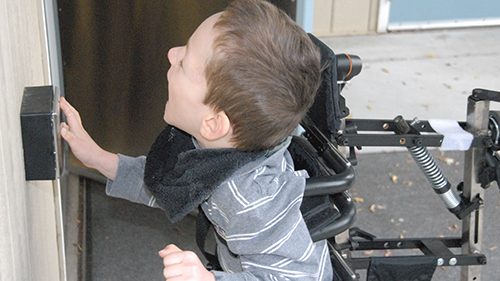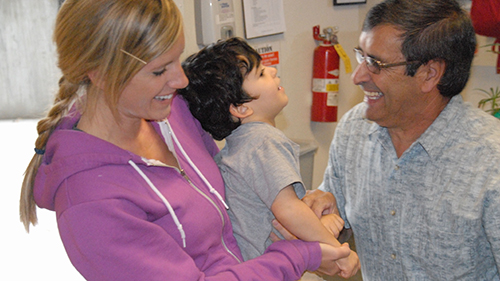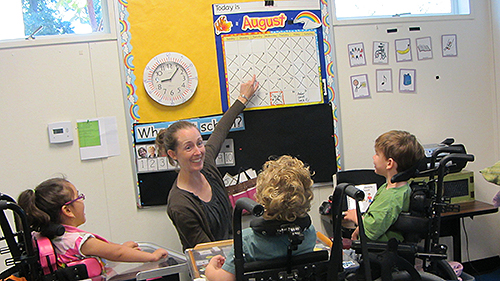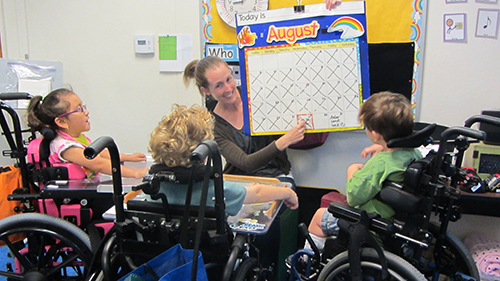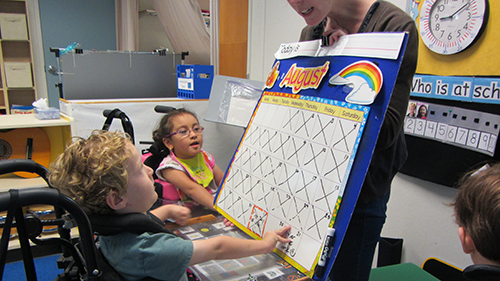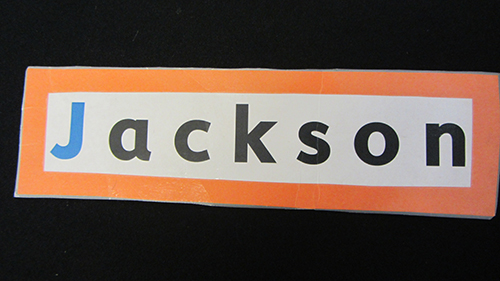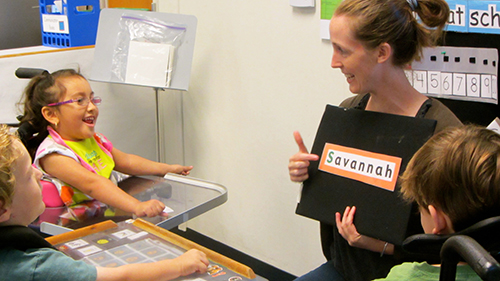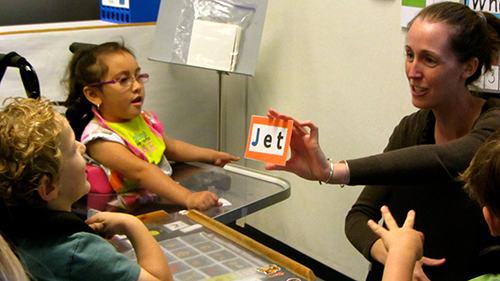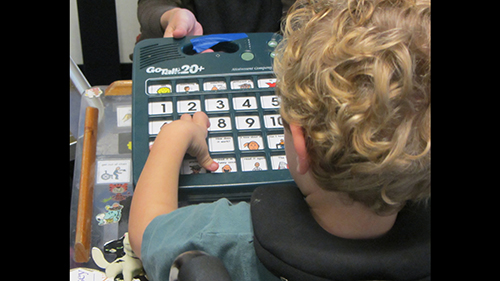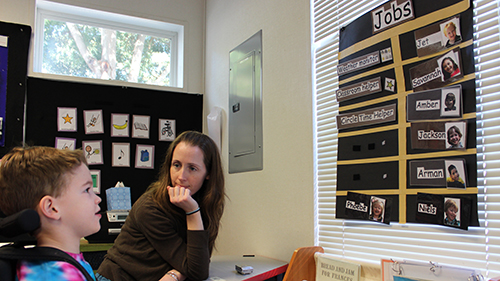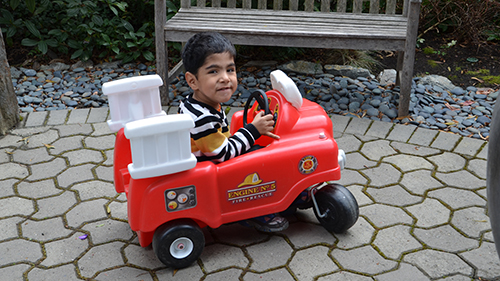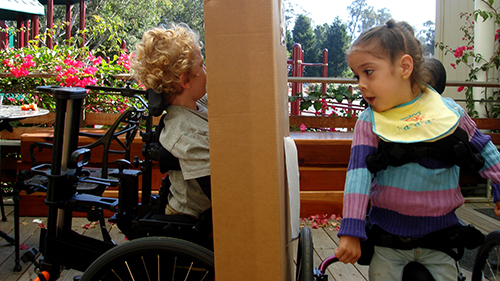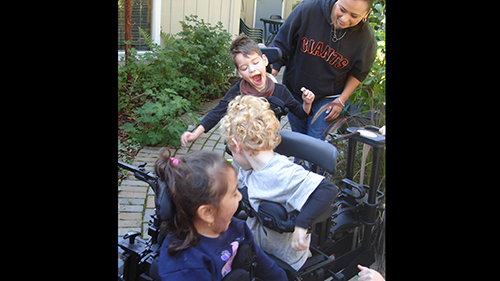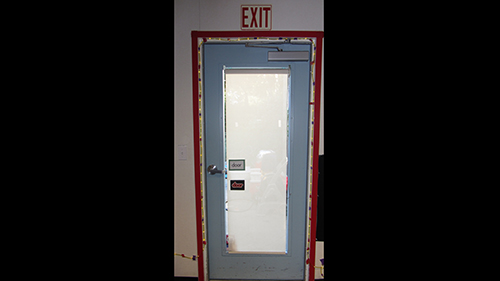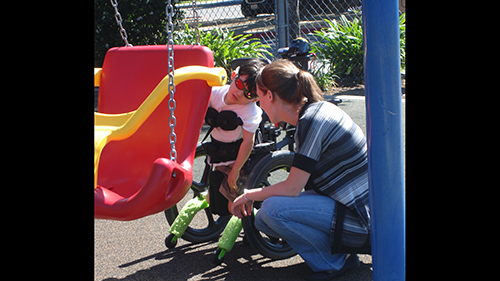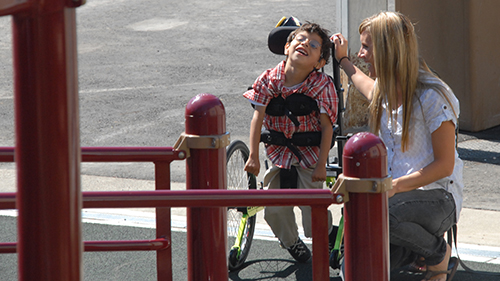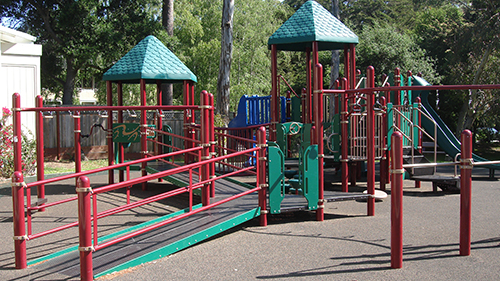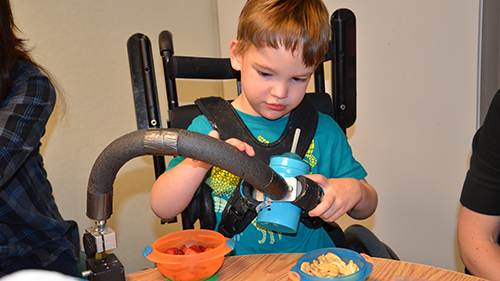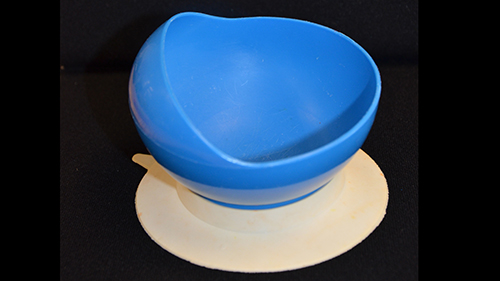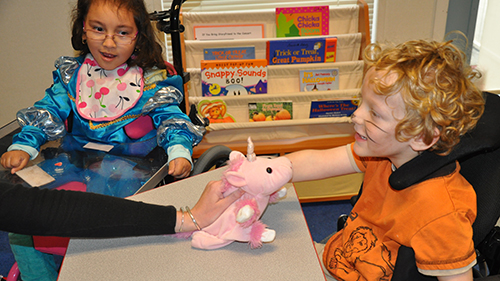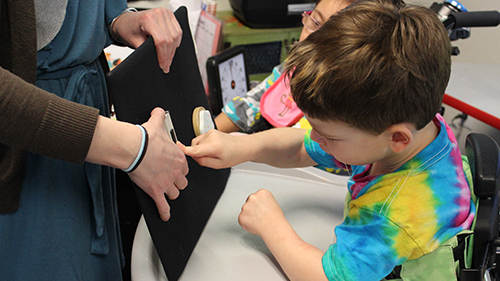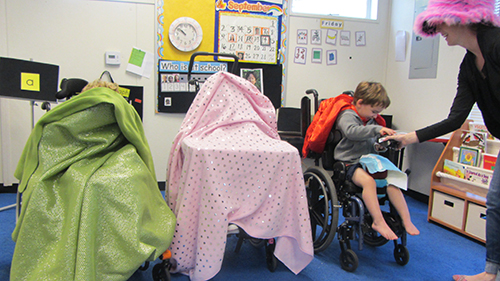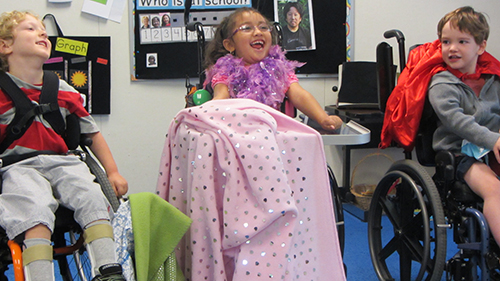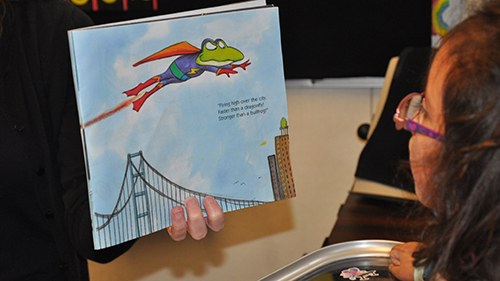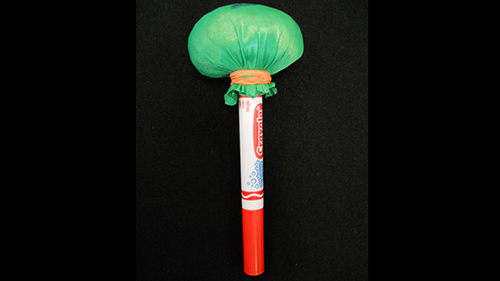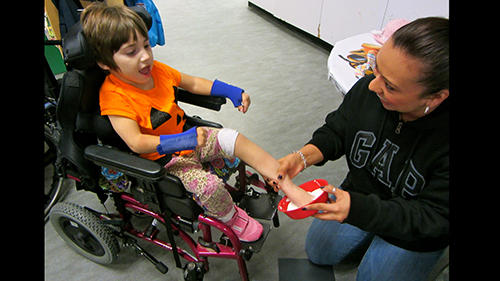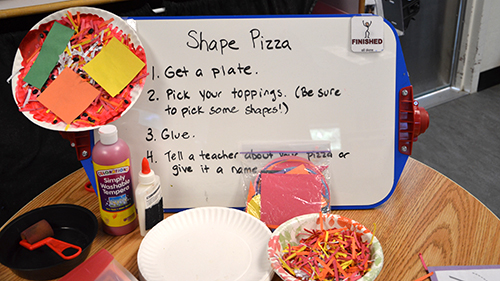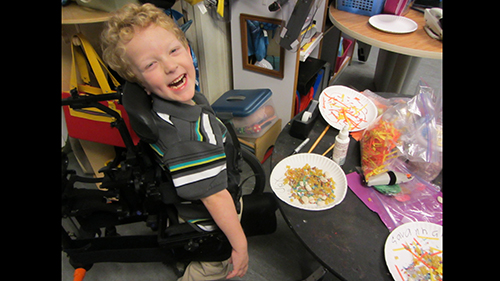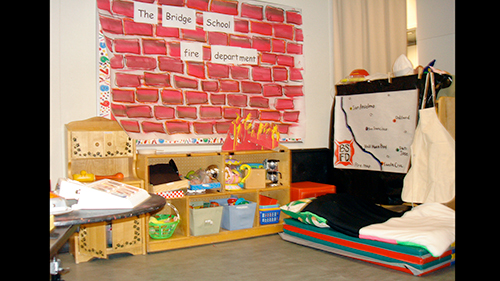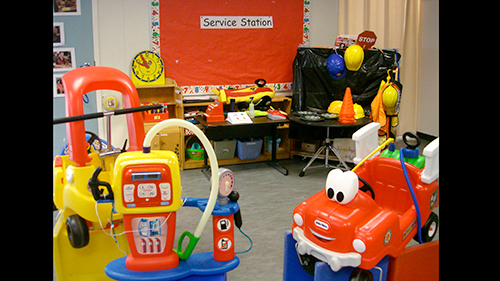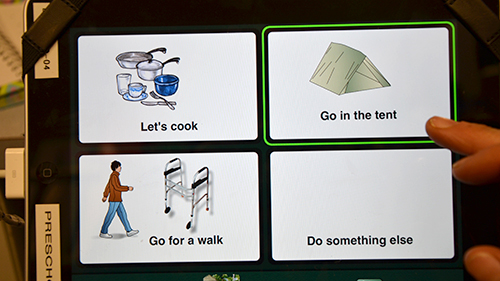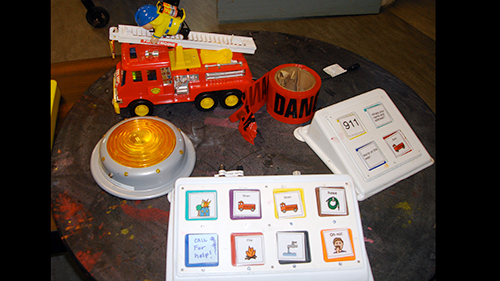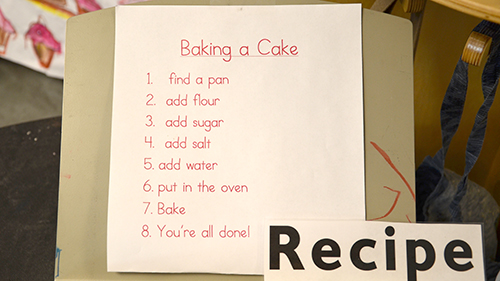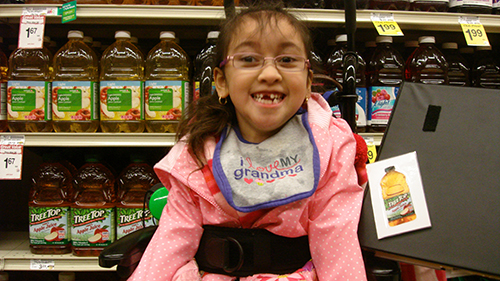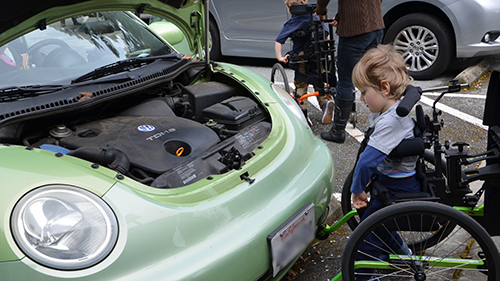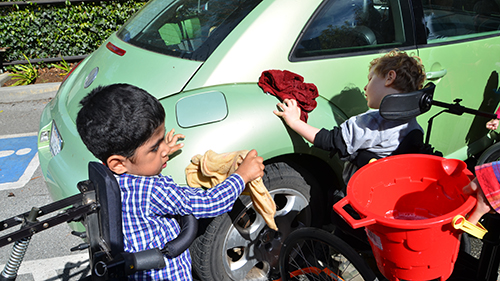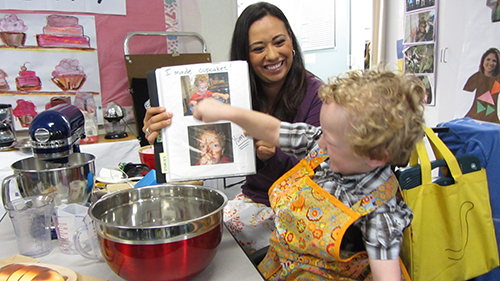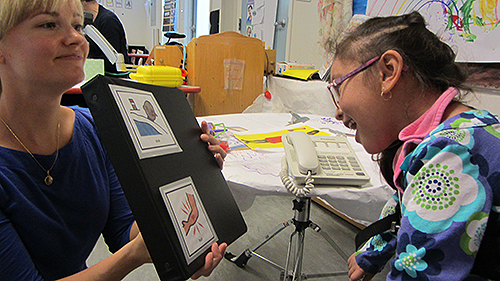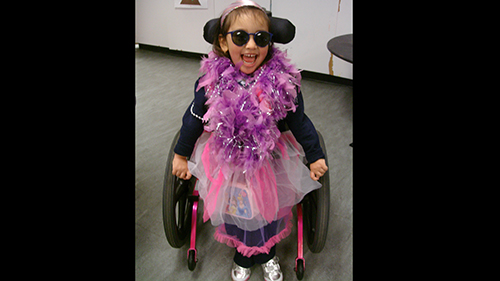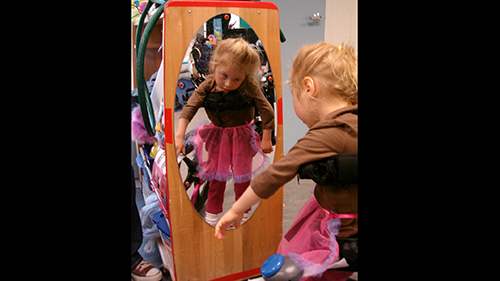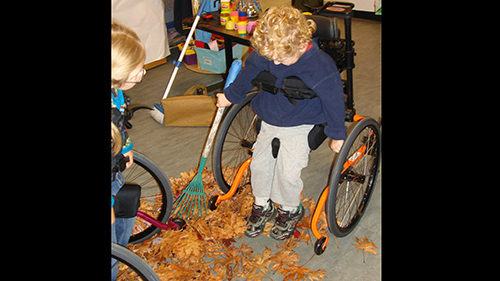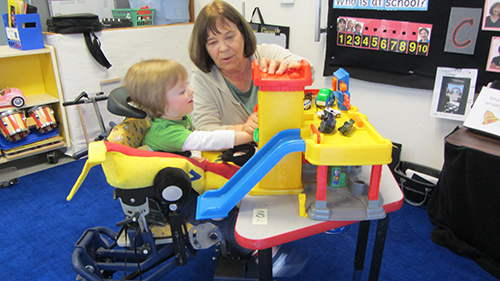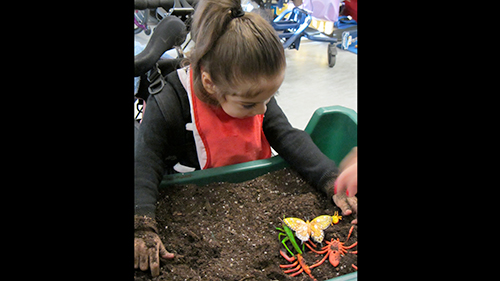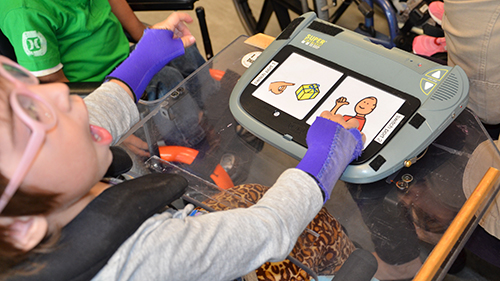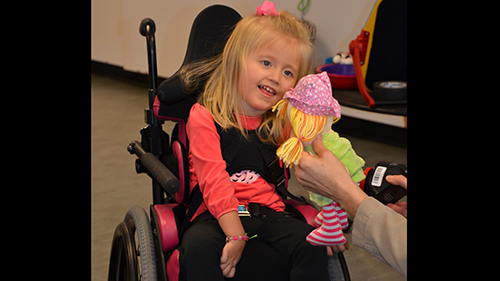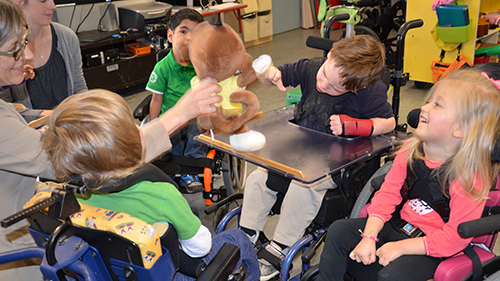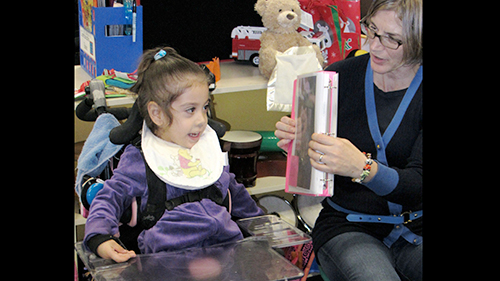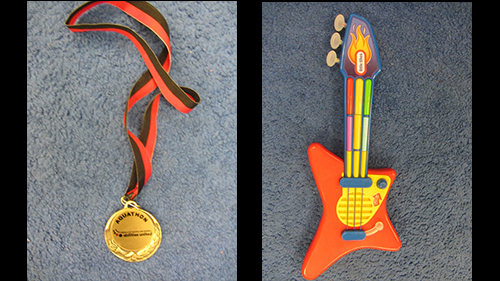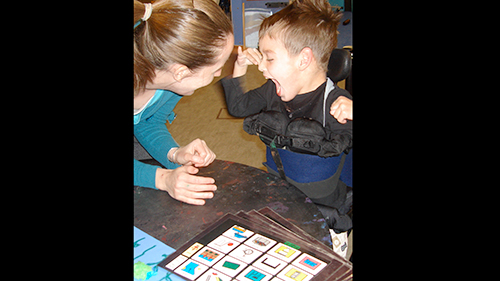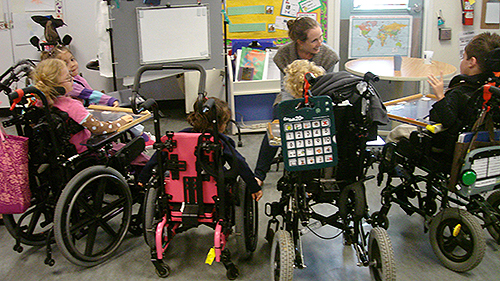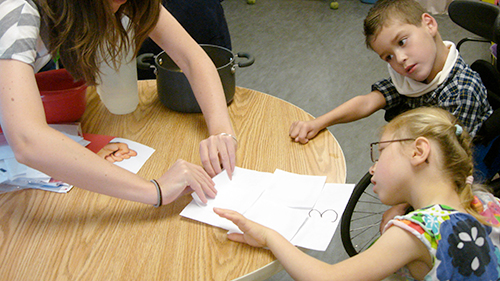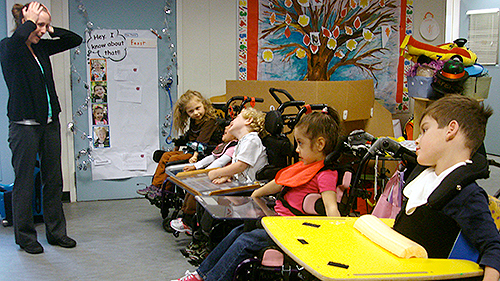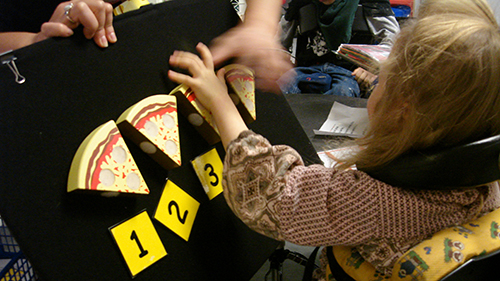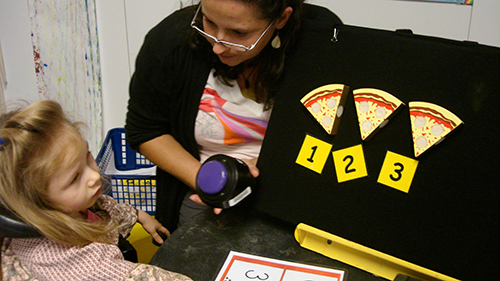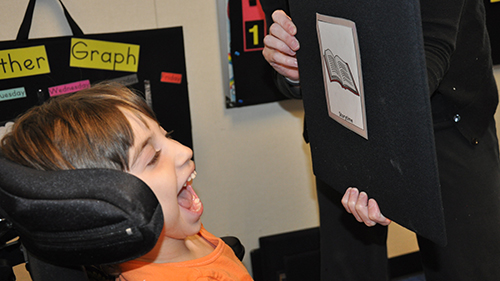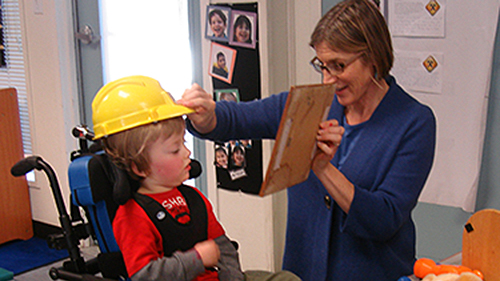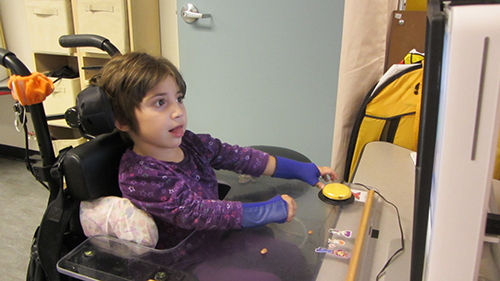Our Preschool Curricular Activities & Daily Schedule – (adapted from Bunce, 2008)
Arrival
Arrival is an important daily activity that sets the stage for the entire day. Arrival provides opportunities for the preschoolers and staff to greet each other and for parents to quickly convey information or updates.
Family members provide transportation for most of our preschoolers, while others arrive via taxi. In order to facilitate a smooth transition from the car to the classroom, just prior to arrival time, our staff moves each student’s school-based seating system (i.e., customized wheelchair or other supportive seating) to our parking lot. Upon arrival at The Bridge School, family members transfer children from their car seats into their customized chairs or walkers and bring them to the classroom where staff and peers welcome them. Family members place each child’s backpack and supplies in their child’s cubby before saying good-bye. Children move to the blue rug for Morning Circle and/or participate in personal care routines. Preschoolers appreciate a predictable schedule including this familiar routine to start the day.
Prior to the arrival time, our staff moves the students’ school-based seating systems to the parking lot. This makes getting the students transitioned from car to school easier and faster.
The location of the door switch ensures that the preschool students can easily access it and independently open the door to the classroom. In his hands-free walker, Will comes from the parking lot straight to the door and delights in being able to do all this on his own.
Once inside the classroom, backpacks and daily supplies are placed in the child’s cubby which is labeled with the child’s name and photo. For students with vision challenges, bright tape or shiny foil is placed around the edges to help the student independently find their storage space.
A quick high-five good-bye sends the family member out of the classroom and the student into the first activity of the day.
Aidan’s grandfather eases the transition from home to school with a smile and a reminder for him to be a good boy!
Morning Circle
When the preschool children first arrive at school, Morning Circle provides a familiar structured routine to help them transition from the home to the school environment. It has long been acknowledged that most children thrive in a structured, predictable situation. A structured approach, providing for some flexibility, allows the teacher and the students to be consistent and this consistency fosters predictability.
Children learn what they can expect to occur next, what behavior is expected of them, and how the teacher is going to interact with them. This familiarity with the routine frees the child to engage in the activity rather than focus on external factors. Routine provides the child a sense of control over their environment. This is one explanation of why a child will ask for the same book to be read over and over to the point they have memorized every line in the story and will resist any attempt by adults to change the words or skip a page.
At The Bridge School, Morning Circle is comprised of 3 activities: calendar, attendance, and the weather graph. At the beginning of the week, two students are assigned a job related to this activity. The Weather Monitor, upon arrival, goes outside to check the weather so they can report back to the group during Morning Circle. The other weekly job is Morning Circle Helper. This child is in charge of directing the teacher as to the sequence of events during the activity and announcing when it is time to move to the next activity.
A familiar routine at the beginning of the school day helps the students transition from the home to the school environment. Talking about who’s at school each morning gives the teacher many opportunities to present each child’s name and emphasize how it’s spelled.
In addition to introducing numbers, the names of months and days of the week, the calendar serves as a point of reference for special events during the month.
Every student wants a turn to inspect the calendar. Having a display that you can move closer to them helps ensure that they can see the relevant things on the calendar and indicate something that might interest them or that they may want to discuss further.
Jet wants to know more about Amber and when she is coming back to school. He can ask Ms. Caitlin by pointing to the place on the calendar with the notice that she is returning.
Savannah is excited to be back in school after the summer break. She’s focused on the first day of school for the year.
Student name cards are used throughout the year in a variety of activities. There is extra spacing between each letter so that students with vision needs can better discriminate the name shape.
The black background reduces visual clutter and helps students with vision needs recognize the visual target. Students have the opportunity to look at and read the name presented within their appropriate visual field and with the assistance of the teacher.
Jet waits carefully to read and hear his name and then lets the teacher know, ‘I’m here!’ by touching his chest and vocalizing.
Because of the range of activities within Morning Circle, it is easy to modify the activity to cater to an individual student’s needs on any given day while also allowing for any extra time needed to implement the use of AAC/AT tools and supports.
All support staff quietly work in back of the students to provide assistance or make adjustments to seating and assistive technology as needed. This is done in ways that minimize distractions and maximize each student’s ability to focus on the leader, peers and salient materials.
Students are assigned jobs for the Morning Circle activity. The weather monitor goes outside and determines which icon is appropriate for that day’s weather. The weather report is programmed on a switch so that the weather monitor can make the announcement to the rest of the group.
Preschoolers take their jobs seriously and the job chart provides a visual reference for them throughout the week.
Jackson uses a number line to count how many students are in class. The students’ photographs are placed above each number as another visual reference.
Savannah uses eye-gaze to pick one answer from the choice of two presented by the teacher. Ms. Caitlin confirms her choice by pointing to the one Savannah looks at.
As the year progresses many students begin to more independently ‘read’ the job chart. Students get additional practice in reading their names and tracking text to determine their job for the week.
During Morning Circle, students are encouraged to:
- Actively participate
- Orient to the curricular materials
- Sustain their attention as a member of a group
- Selectively attend to the leader and relevant materials
- Regard their peers
- Help direct the teacher in following the Morning Circle routines
- Take turns
- Practice counting and calendar skills
- Practice reading different materials with picture supports
- Make choices regarding activities
- Ask and answer questions
- Listen to others
At the end of Morning Circle, students are transferred into supportive walkers and move to Outside Time.
Outside Time
Outside Time is a child-directed activity that gives students the opportunity to play outside and in another environment besides the classroom. Depending on the day, students play either in the backyard garden area or on the shared adapted playground with North School. Toys and activities have been engineered to maximize access, participation, and interaction. Students are positioned in hands-free support walkers so they can independently move around the space to explore different areas. When appropriate, teachers work on cooperative play skills as they encourage games and interactions between peers. Outside Time lasts 25-30 minutes.
During Outside Time, students are encouraged to:
- Experience upright, independent mobility over varied terrains
- Ambulate independently to, from, and around the garden and playground
- Observe changes in nature, including plants, insects, birds, and weather
- Experience different toys, activities, and games played outside
- Be imaginative and play
- Participate in group games with peers
- Move around, explore and have fun!
Jet and Adam can’t wait to get outside ahead of the teachers. Jet reports that Outside Time is his favorite time of the day.
The preschool environment has been engineered so that across the room there are a variety of AAC/AT tools and supports children can access for a variety of communication purposes. Will walks to the door in his hands-free support walker and touches the BIGMack Communicator switch to tell his teachers, ‘It’s time to go outside!’
Being outside allows the students time to observe the environment and the changes that occur across seasons. Adam helped plant the seeds and now he is ready to harvest the lettuce in the garden. The planting bed is raised so that it can be easily accessed by students in hands-free support walkers or in wheelchairs.
Arman’s favorite toy is the fire engine. He uses his feet on the ground, rather than the pedals, to propel himself independently around the garden, classroom, parking lot, and playground.
Boxes and packing crates provide excellent opportunities for creative play. Jackie and Jet built a maze out of these boxes and then chased each other around the deck.
Tag is always a favorite game amongst the preschoolers. Hands-free support walkers make it possible for them to play this game independently. Adam is ‘it’ and chases after his friends as they run away.
Our students love playing with the accessible sand and water tables. These are placed at a height that allows the children to see and reach the objects in each and to interact with each other as they play. Arman and Phoebe are washing some dishes together.
The door to the garden is highlighted in red tape and a string of lights so that students with vision needs can locate it from across the room.
Students get to choose what activity they want to do when they are outside. Aidan walked over to the swing in his hands-free support walker to tell Ms. Caitlin his choice.
Students have the opportunity to interact with same-age peers from North School when they are on the playground. When necessary, Bridge School staff support peer interactions.
A large, colorful parachute can be used in many different games and students love to be involved. When we take a parachute outside, children from North School frequently join in the fun.
Joey loves to explore and is ready to embark on a ‘playground adventure’ with Ms. Lindsay. He walked all around the playground to see what he could find.
The Bridge School parent group partnered with North School parents to redesign and construct a playground that would be accessible for all students. This play structure is equipped with ramps and other accessible features that allow students in wheelchairs or hands-free support walkers to access it independently. The rubberized playground surface is smooth so that wheels can easily move across it.
Mid-Morning Meal
During Mid-Morning Meal, students receive appropriate nourishment and hydration while positioned in individualized seating systems. The students’ families provide the documentation, and training when required, and the staff follows individual feeding protocols and physician-authorized, specialized physical health care procedures to ensure that the student receives proper nutrition. When appropriate, students work on self-feeding skills. Using various individualized AAC/AT tools and supports, students engage in social conversations with teachers and peers by sharing their home news with the group and talk about what they did at home the previous day. The Mid-Morning Meal lasts from 20-30 minutes, depending on student needs.
During Mid-Morning Meal, students are encouraged to:
- Work on aspects of self-feeding when appropriate
- Participate in many aspects of the feeding process including making food or drink choices, expressing preferences, and directing adults to locate utensils and food-related items brought from home
- Share home news
- Listen as peers share home news and make comments if desired
This custom-made cup holder allows Jackson to independently pull the cup towards his mouth when he wants to drink.
Commercially available suction cup bowls keep the bowls steady and in one spot so that students can more easily find and scoop food items.
A variety of adapted utensils are commercially available. These utensils have a range of different textures, grips, and widths. The middle spoon is curved to help students more easily angle the food into their mouth.
From a choice of two food items, Savannah used her eye gaze and voice to say she wanted to eat her pudding. She then works on self-feeding with assistance from the teacher. The teacher helps maintain Savannah’s grasp on the spoon, while Savannah independently brings the spoon to her mouth when she is ready for a bite.
Using a Step-By-Step, Jet shares a funny story on his home news with the group. He told his friends and teachers how his Daddy got all mixed up helping him get dressed this morning. Jet’s Daddy put his socks on his head!
Mid-Morning Meal, in addition to providing needed nutrition, is a time for social interaction and sharing. The preschoolers look forward to this activity and have a lot to do and learn.
Storytime
Storytime is a teacher-led activity, lasting 15-20 minutes, that encourages students to listen to, enjoy, and respond to a book, while also reinforcing vocabulary concepts and knowledge related to the theme. One book is chosen for the duration of the theme so that students have multiple exposures and experiences with the same content. Using a variety of augmentative and alternative communication and assistive technology (AAC/AT) tools and supports, students are encouraged to participate by reading a repeated line, acting out certain parts through gestures/body movements or with props, or answering teacher-posed questions to practice new vocabulary.
During this time students also learn more about books and print concepts. ‘Storyfriend’, a stuffed animal puppet, joins the group each day. Students are reminded that ‘Storyfriend’ does not know much about stories and that together we will teach her all about books. Students are then able to become the teacher, showing ‘Storyfriend’ how to look at a picture, turn the page, read the title, etc. To support comprehension, content from the book is tied to each student’s individual experiences.
Prior to the start of every thematic unit, family members send in a note that details their child’s experiences with the current theme. These notes are placed on the “I Know About That” board and students will refer to that board during Storytime. The teacher also pulls from this information to tie book content to personal experiences, which provides many students with a richer and more meaningful understanding of the book. At the end of each week students participate in a Reader’s Theater, where they pick one part of the story to act out, providing another way to interact with the book.
During Storytime, children are encouraged to:
- Listen to and enjoy the story
- Take an active role
- Participate by using voice, gestures, body movements, and assistive technologies
- Practice new vocabulary concepts
- Ask and answer questions
- Experience props and vocabulary related to the theme
- Tie personal experiences to book content
Every student has a chance to say, ‘Hi’ to ‘Storyfriend’. Then the teacher asks students to tell ‘Storyfriend’ about the book we are reading, giving them another opportunity to practice and recall new vocabulary concepts and access to their AAC/AT tools and supports.
While reading the book The Doorbell Rang, by Pat Hutchins, the students rang a real doorbell and passed out play cookies to support comprehension of the content. Materials were mounted on a black background to help reduce visual clutter and help students with vision needs more accurately find the desired prop.
While reading a book about construction, students were able to use a variety of tools seen in the book. This hammer has been adapted with a rubber band support so that students can independently hold the prop on their wrist and hammer in the pretend nail.
Ms. Dana explains to Roman and Cannon that the purpose of reading this book is to learn more facts or true information about dinosaurs.
Joey is drawn to the picture of the red fire engine. Ms. Janelle explains how we can use the pictures to ‘read’ and tell us about what is happening in the story. Then she points to the print where we read the words. She also demonstrates how to track the text from left to right by following the print with her finger.
Students can refer to the ‘I Know About That’ board during Storytime and Centers to connect personal experiences to the book and theme content knowledge.
Jackson raises his hand to tell his teacher he knows something about the fire station while reading the book Dot the Fire Dog, by Lisa Desimini. By reading the note from home on the ‘I Know About That’ board, it is discovered that Jackson has visited the fire station close to his house several times.
As the teacher continues with the book she is sure to point out things in the fire station that Jackson has seen, even including some new features that Jackson did not know about. For example, firefighters sleep at the fire station in a bed, just like you!
During Reader’s Theater, the students choose one part of the book to act out. They pick the parts to play and put on costumes from the dress-up rack. Jet, Savannah, and Jackson have decided to act out the part in The Very Hungry Caterpillar, by Eric Carle, where the caterpillar pops out of the cocoon.
Jet and Savannah are the part of the caterpillar, and Jackson plays the role of the narrator. He uses a Step-By-Step to tell that section of the story.
Jet and Savannah act out the part and ‘pop’ out of their blanket cocoons just like the caterpillar does in the book. The acting part takes only a few minutes, but the preparation offers the students many opportunities for choice making, communication, and fun with the book.
Storytime allows students to experience the joy of reading and storytelling, a critical component of the literacy experience.
Centers
The main purpose of Centers is to allow students the opportunity to play and explore with objects and concepts related to a thematic unit. Students choose between four centers – art, pretend play, computer, or book area. Each center has activities related to the theme. Themes change every two weeks and include camping, veterinarian’s office, community helpers, bakery, and service station.
Centers lasts up to 45 minutes and is primarily child-directed, where the child chooses which activity center to participate in and is provided with several choice making opportunities and communication supports within each activity. Often, a child will rotate through several center stations across the 45-minute period. Students are positioned in upright hands-free support walkers so they can independently move through the centers and access the materials. During Centers, literacy, mathematic, and other ‘concept focus’ skills can be reinforced during the child’s play and in the various center areas.
Concept focus skills are identified and addressed to support students conceptual, mathematical, language, and vocabulary development. They may include relational words (big/small, hot/cold), science concepts (plants need sun, water, air, and soil to grow), or concepts that further enhance a child’s understanding of the theme (leaf rubbings during the Fall theme). Centers requires significant planning, engineering and supports to enable children to become increasingly independent and self-directed in choosing their level of participation at the various centers, and supports the understanding that above all a child’s job is to play.
Art Centers
Art activities relate to the theme and use a variety of different mediums across the school year. When necessary, tools and materials used in art have been adapted so that students can independently access and create their own artwork. Students are offered a variety of choice-making opportunities across the art activity, and communication supports are put into place so that the child can direct the teacher on what they want to do next in the art project.
Many students choose to display their artwork on the classroom art wall and feel proud to show it off to friends and teachers.
Materials are adapted to ensure more independent access. Foam has been added to the top of this pen so that the student can more easily grasp the pen.
Amber chose to make a footprint ghost for art during the Halloween theme. She painted with her feet.
During the Scientist theme, students mixed paint to get new colors just like in the book we were reading, Mouse Paint, by Ellen Stoll Walsh. Savannah independently mixed the paint colors with her feet while positioned in her hands-free support walker.
Directions for the art project, along with a completed example, are provided on a dry-erase board. Students are provided with another exposure to text in a list format. They can check off each direction as the task is completed.
While positioned in her hands-free support walker, Abigail is able to walk directly up to the art wall and hold onto a rounded handle paintbrush to add to the classroom fall tree mural.
While making a card for his mom, Jackson used his hand to spread the red glitter glue around. He then chose a picture to glue onto the card.
During the Shopping Mall theme, students browsed through catalogues and created ‘wish lists’ of things they wanted from the mall. They used adapted scissors to cut out the items they chose and then glued them onto the list.
Jet used shredded paper, beans, pasta, and rice to glue onto his pretend pizza at the art table during the Pizza Parlor theme.
Pretend Play
Every two weeks the pretend play area is transformed into a new play context. Materials that relate to the theme are made available to the students and allow for a variety of play schemas to unfold. Low-tech, mid-tech, and high-tech communication tools and supports are created and programmed so that students can practice and learn vocabulary concepts within a play schema and more independently act out the script with friends and teachers. The teacher, speech language pathologist, and instructional assistants all work closely together to plan and implement the pretend play center.
During the Firefighter theme different play schemas and the materials to support them are made available. In the ‘firehouse’ students can choose to cook, get ready for bed, take phone calls, or study the map. Students also have the option to pretend to drive the fire truck and fight a fire.
During the Service Station theme students have many play routines to choose from. Students can drive the car and fill up at the gas station, be a gas station attendant, fix cars, or take phone calls to set up appointments at the car repair shop.
Using the GoTalk Now app on the iPad, pre-programmed scripts are created so that students can independently access and act out the vocabulary while playing camping.
Various mid-tech devices are programmed for the students to access and use while playing during the Firefighter theme.
Various environmental print and print materials are placed throughout the pretend play area to support literacy skills. During the Bakery theme, a cake recipe was created so that students could experience reading a list.
Picture supports along with written words help students read the menu available at the ‘Bridgeville Café.’
As often as possible, real world experiences are made available to the students to provide for deeper understanding of the theme and theme concepts. Aidan feeds a sheep during the Farm theme. A mobile petting zoo was able to bring several animals to The Bridge School.
Jet took a field trip to the grocery store to learn more about the theme. He was able to independently choose what to explore in the store while positioned in his hands-free support walker.
As part of the grocery store field trip students wrote a grocery list in order to make fruit smoothies. Every student was in charge of getting a specific item. Savannah found the juice aisle and picked up some juice for the class.
During the Service Station theme Ms. Lindsay opened up her car for the students to explore. Niels is checking out Ms. Lindsa’s engine and can later use this real world knowledge to enhance his understanding of the pretend play schemas.
The next day students washed Ms. Lindsay’s car, just like they might act out in the pretend play area within the classroom. Jet and Arman can get very close to the car and use their hands while positioned in their hands-free support walkers.
Jet uses his personalized low-tech communication book to tell Ms. Laura all about a time he made cupcakes at home during the Bakery theme.
Families write in about what their child knows about/has experienced in relation to the theme so that familiar concepts can be incorporated into play routines, allowing the students an even richer and more relevant experience with the theme.
During the Doctor theme, two vocabulary words studied were ‘sick’ and ‘hurt.’ Here Savannah is using her eye gaze to make a choice of why Ms. Holly needs to call the doctor’s office.
Dress-ups are always available to the preschoolers. Savannah put on a special outfit to wear to the mall during the Shopping Mall theme.
Abigail put on a dress up skirt, then checked herself out in the mirror. Children love looking at themselves in the mirror, which also helps promote positive self-esteem and image.
Jet rakes leaves during the Fall theme. In his hands-free support walker he is able to look down and see what he is doing. He was sure to run through the leaf pile once it was complete. The upper handle of the rake has been built out with some thick tape for students to better grasp it independently.
Niels plays with the toy garage. The garage has been placed on a raised table so that he can more easily access and manipulate the different garage materials.
Teachers show how to play/act out different play contexts and provide the students with appropriate language models. Ms. Elisa acts out the part of the police officer during the Community Helpers theme. When Abigail is done driving the bus she can take on the role of the police officer and know what to do and say.
Jackie and her teacher count how many toy insects she finds while digging in the dirt during the Garden theme. She wanted to give one insect to each of her friends so she needed to make sure she had enough. Counting and other mathematic concepts can be incorporated within a child’s play routine while still keeping it fun.
Sharing
Sharing is a teacher-led activity that lasts between 15-20 minutes. At Sharing, preschoolers take turns sharing items and asking each other questions or making comments about the items brought from home. Along with their item, each child shares a series of prerecorded messages describing the item: what it is, how it looks, how it works, and/or why they like it. Classmates listen, ask questions, and touch or explore items as the child shares and passes them around for the group to look at, play with, or hold.
Getting ready to share: Ahead of time while still at home, children choose an item to show, tell about, and share with their peers. Together with a family member, children generate prerecorded messages to say while sharing their item. Messages are pre-recorded using simple SGDs such as a Step-By-Step Communicator. A family member may ask the child, “What would you like to share about this?” The family member records the child’s messages into the SGD while incorporating the child’s speech and vocalizations, whenever possible, into the recordings.
Sharing is a group experience. During sharing at school, everyone participates using facial expressions, eye gaze, gestures, and pre-recorded, scripted messages that offer consistent vocabulary programmed into various augmentative and alternative communication and assistive technology (AAC/AT) tools and supports. Vocabulary for classmates includes questions, such as, “What is it?” or “Can I see?” and comments such as, “I like it” or “I love it.”
During Sharing Time, students are encouraged to:
- Ask and answer questions
- Make comments to the group
- Listen to classmates
- Notice shared or novel experiences and toys
- Experience new toys, photos, ideas, and concepts
- Practice AAC system use
- Take turns
- Practice briefly ‘holding the floor’ in front of a group
- Call on classmates to ask questions
- Share family traditions, culture and familiar experiences
Phoebe uses a Step-By-Step to tell her friends all about her new doll and what she likes to play with her.
Student sharing items are placed on the sharing table and remain there throughout the week. Students are welcome to go play with the sharing items (after asking their friend first) at other times in the day. Additional practice with reading names is available during Sharing. A list of students who want to share that day is created and students can read who is next on the list and know when it is their turn.
Reading and Math
Reading and Math is a teacher-led activity that lasts 15-20 minutes. The primary purpose of Reading and Math is to acquaint the preschoolers with what it means to be an active learner and participate within a larger group lesson directed by a teacher. The instruction is differentiated so that students are all expected to participate at the appropriate level, ask and answer questions, and make comments. During this time students learn to take instruction and direction from the teacher, wait for a turn within the larger group, and participate in the lesson as an active learner. There are several short activities within the lesson to help keep the preschoolers engaged and interested. The activities consist of quick instruction or direction, followed by student participation to learn and reinforce the concepts. Activities are created that cater to student interests so that the instruction is always fun and relevant.
Literacy concepts addressed include phonemic awareness of initial sounds, identification of written letters, blending sounds, and rhymes. Mathematic concepts include counting and the count sequence, one-to-one correspondence, patterns, and shape identification. Instruction and direction in foundational concepts is also addressed at this time and helps promote conceptual, literacy, mathematic, language, and vocabulary development.
During Reading and Math, students are encouraged to:
- Pay attention to the teacher
- Listen to and comprehend spoken information
- Take turns
- Respond to questions and requests from the teacher
- Explore literacy, mathematic, and foundational concepts such as letters, numbers, sizes, and colors
- Actively participate in activities
- Ask questions and make comments
- Complete activities and games the teacher has set out
- Have fun during instruction as a member of the group
Adam uses his voice to tell Ms. Caitlin that letter a says, ‘a,’ which is also the first letter sound of his name!
During Reading and Math students are expected to be learners within a larger group. This gives students the opportunity to practice taking turns, listening to the teacher and the directions, and finding ways to remain an active participant and learner.
Activities are created that allow hands-on opportunities for learning. Abigail is completing a counting puzzle, where she must cover all 3 squares while learning about the number 3.
Jet learns about the number 4 and counts that there are 4 wheels on a car. Later that day he relates what he has learned to his everyday environment by counting the number of wheels on his own car and finding out there are 4.
The preschoolers could not believe it when they found out that there are also 4 wheels on Ms. Caitlin’s stool. That number 4 is everywhere! The teachers find multiple ways to reinforce concepts whenever the opportunity arises.
While learning about patterns, the preschoolers created their very own with Ms. Caitlin. Uh-oh, Ms. Caitlin made a mistake though and broke the pattern. Can the preschoolers help her figure out her mistake?
Will learns about the words ‘big’ and ‘little’. He had a chance to hold and feel a little pumpkin, then later he did the same with a big pumpkin. It is important to provide multiple sensory inputs as children are exposed to concepts: look at the difference, feel the difference, tastes the difference, and/or hear the difference.
Ms. Sasha teaches the preschoolers about the color yellow. They get to make choices on the yellow objects they want to hold, feel, and interact with; later they made a painting using the color yellow.
Later, Abigail counts the slices of pizza again, this time using a Step-By-Step, so that she can independently produce and say the numbers.
Music
Music is a 15-20 minute, teacher-led, daily activity. Children enjoy singing and moving to songs that integrate theme-related concepts, props, and vocabulary. We choose one or two songs per theme and then modify, and structure each song in ways that provide students with multiple opportunities for repeated practice, using a variety of actions, gestures, tunes, sounds and sound effects.
Songs allow us to specifically target the use of potential communication tools including gestures, vocalizations, and augmentative and alternative communication/assistive technology (AAC/AT) tools and supports that can be used in other situations. The rhythm of the song can help children organize and remember their parts. Clear pauses and expectant waiting are used to cue children to take their part.
Over a two-week period, students can learn the expectations and timing of the song and become more independent and adept at participating in various ways. In addition to providing structured practice in the use of AAC/AT tools and supports, Music addresses several important foundational literacy skills including rhymes, play on words, and vocabulary development.
During Music, students are encouraged to:
- Practice using body movements, gestures and vocalizations
- Actively participate
- Practice technology access skills
- Practice timing in participation of the song
- Use a variety of AAC/AT tools and supports to participate
- Learn and enjoy different rhymes and rhythms
- Pay attention to the teacher and spoken directions
- Learn the routine within the song
- Have fun as a member of the instructional group
The iPad has a variety of apps, including GoTalk Now and Sounding Board. These can be programed so that students can participate in the singing of the song. During the Farm theme students sing, ‘Old MacDonald Had a Farm.’ Using the GoTalk Now app, Jet was able to decide what animal would come next in the song and tell everyone the sound that animal makes.
Several props related to the theme are incorporated into the song to help with comprehension of the song’s meaning and order. Students are positioned in their hands-free support walkers so that they can have both hands available to hold and manipulate the props. Amber is picking some fruit while singing, ‘Way Down Yonder in the Paw-Paw Patch,’ during the Garden theme.
Students use body movements, gestures, and vocalizations throughout each song. This allows the student to gain extra practice in the production of these communication intents, and supports their growing knowledge of different ways to communicate. During the Jungle/Safari song, Adam roared like the lion. Adam began to roar like a lion the next day during Outside Time as he chased his friends around the garden in a game of jungle/safari tag.
The staff create PowerPoint slides to accompany each song. This reinforces concepts, promotes literacy, and provides students with prompts of what happens next, especially while learning the song. The backlit screen and movement between the transitions of slides attract visual attention and support students with vision needs to know where to look.
Savannah gains additional practice in using her AAC/AT tools and supports to count during the song, ‘Five Little Monkeys.’
School News and Dismissal
At the end of the school day, students and staff collaboratively construct a brief message on a simple voice output communication aid (VOCA) such as a Step-By-Step. This message reflects something the child wants to share with their families about what happened in school that day. The student chooses which parts of the day to talk about and, after given several options, chooses what they want to discuss.
Once school news is complete, students have a few minutes to engage in independent time. During this time students are encouraged to independently access and participate in a fun, leisure activity, including computer activities, reading a book, doing art, or playing with a switch-activated toy. Five minutes before dismissal, students gather in a circle where the teacher discusses anything important that happened that day or reminds students of the activities that will be coming up the next day based on the calendar.
Students and staff then sing the good-bye song. Students are expected to participate in the song by using gestures and vocalizations. The classroom helper then goes to the door and everyone gets in line. Staff assists students out the door to waiting family members. School news and dismissal lasts approximately 15 minutes.
During School News and Dismissal, students are encouraged to:
- Make choices
- Use gestures, vocalizations and appropriate AAC/AT tools and supports to collaboratively construct a school news message with staff
- Participate in a variety of potential leisure activities
- Transition between school and home with confidence
Students go to the posted schedule of the day and pick one to two parts of the day to talk about on their school news.
Amber picked Storytime to talk about for her school news. The teacher then gives her choices on different things that happened during Storytime. Amber chose to talk about how she held Storyfriend during Storytime and that she read the line in the book, ‘We’re going to the moon!’
Remnants from the day can accompany school news. Arman chose to talk about his art project for school news and then brought his art work home to share. When students choose Music as their school news topic, they often enjoy including parts of the recorded song in their message.
Sometimes the students need reminders as to the events of the day. Niels tries on his favorite construction hat and tool belt from Centers with Ms. Elisa, then he picks what to talk about on his school news.
Jet uses a gesture to tell Ms. Elisa he wants to talk about the part of the ‘Five Little Monkeys’ song where Mama calls the doctor in his school news.
Amber plays a computer game during independent time. Once the switches are set up she is able to independently play and access the game. She uses her voice if she needs to call the teacher over for assistance.
During independent time Arman plays with some of the toys and materials set out for Outer Space, the current theme. Arman is able to move between the toys and materials as he pleases in his hands-free support walker; he walks over to the teacher if he needs assistance.
Phoebe does some last minute painting during independent time. She can use her foot to independently create her masterpiece.



